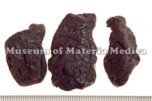Processed Rehmannia Root

|
Market name:熟地黄 Photo location:Museum of Materia Medica, Inst. of Nat. Med. TMPW No.:11364 |

|
Plant name:Rehmannia glutinosa Photo location:Nara Pref., Japan Photo date:1997 Photographer:K. Komatsu |
| Synonym | |
| Latin name | Processi Rehmanniae Radix |
| Botanical source: Family name | Scrophulariaceae |
| Botanical source: Plant name | - Rehmannia glutinosa var. purpurea Makino - Rehmannia glutinosa Steudel (IPNI:808644-1) |
| Part used | Rhizome, which has been repeatedly processed of being dried, steamed with alcohol and sun-dried. |
| Empirical criteria for quality selection | Blacker, shinier, sweeter and larger ones are regarded as high quality (NI). |
| Constituents | Lipids: Cerebroside, Jio-cerebroside Sugar: Manninotriose, Verbascose Monosaccharides: D-Mannitol, D-Glucose, D-Fructose, D-Galactose Oligosaccharides: Raffinose, Stachyose, Sucrose Monoterpenoids: Iridoids: Catalpol, Aucubin, Rehmannioside A, Rehmannioside B, Rehmannioside C, Rehmannioside D, Rehmaionoside A, Rehmaionoside B, Rehmaionoside C, Rehmaionoside D, Melittoside, Leonuride Carotenoids & Vitamin A: Vitamin A Sterols: Sitosterol Phenol derivatives: Acteoside Amino acids: Arginine Other: Fe |
| Pharmacological effects | Hypoglycemic, cardiotonic, hypertensive, diuretic (extract). Cathartic and diuretic (catalpol). |
| Indications | As a tonifying and heat-clearing drug, for reducing heat in blood, it is applied to treat anemia, hematemesis, diabetes, night sweat, pollution, mental instability and infirmity. |
| Diseases | Lightheadedness, Vertigo, Bleary eyes, Palpitation, Irregular menstruation, Menorrhalgia, Irregular vaginal bleeding, Pain due to flatulence of hypochondrium, Night sweats |
| Formulas | kanroin , jijinmeimokuto , junchoto |
| Meridian tropism | Heart, Liver, Kidney |
| Property | Slightly warm |
| Flavor | Sweet |
| Classification in "Shen-non Ben-cao Jing" | Superior |
| TCM: Classification | Tonics |
| TCM: Medicinal effects | To nourish yin and replenish blood, reinforce the essence of life and marrow. Used for yin deficiency of liver and kidney, aching and weakness of the loin and knees, hectic fever and bone-heat, night sweat, emission, internal heat and thirst. Anemia with sallow complexion, palpitation, a kind of neurotic, menoxenia, uterine bleeding, dizziness, tinnitus, white hair and beard in young age. |
| Remarks | Listed in the Japanese Pharmacopoeia 18th ed. |
| References | NI: N. Isshiki, Methods of Quality Evaluation and Preparation of Wakan-yaku, Tohodo Shoten, Tokyo, 1987. |
DNA sequences of medicinal plants
